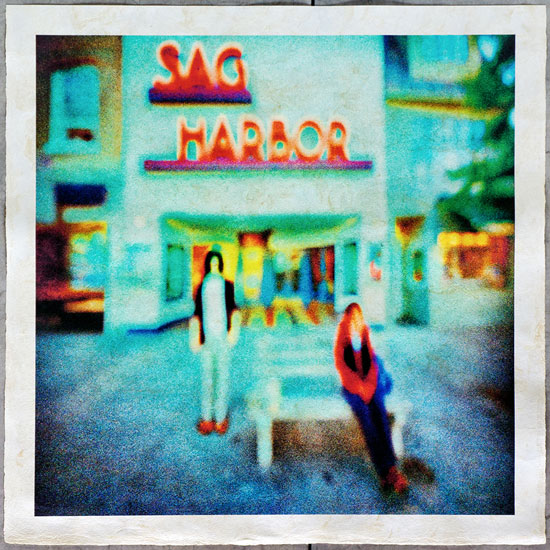Stephen Schaub has a lot of stories to tell. Most of them can’t be gleaned at first glance at his art. His compositions seem like they're photographs capturing scenes viewed through rain-soaked ultraviolet glasses: everything is familiar but things are blurry and the colors are intense.
Schaub's photographic prints are what Claude Monet (1840-1926) might create if he had access to cutting edge technology and felt playful with colors. Like Monet, Schaub strives to capture the act of perception. Unlike Monet, Schaub wants the perception to arise from the viewer looking at the artwork and not from his impression of the scenes he photographs.
.

Artwork by Steven Schaub.
.
Schaub's work is distinctive narrative. A single figure or pairs or small groups of people fragmented from each other are prominent in a series of new artworks inspired by the Hamptons. The photography-based works are on view at Peter Marcelle Gallery through Sept 25, 2012.
The large-scale artworks are soaked with colors that may shock. Highly saturated, the vivid palettes ferry the recognizable into a world of dreams or imaginary tales.
"My work is an unresolved narrative," said Schaub. "It depicts in-between moments and anonymous figures in scenes of hyper-reality."
.

Artwork by Steven Schaub.
.
When creating these new works, Schaub set out to capture quintessential Hamptons locales. Bringing an outsider's perspective (he is based in VT), Schaub and his camera traveled to Sag Harbor, Montauk and Bridgehampton. The resulting art is a mix between the recognizable and places that could be familiar. Businesses with distinctive architecture can be easy to identify (Sag Harbor Movie Theater, the Candy Kitchen, The American Hotel). Beach scenes and farm fields could be from anywhere. This is the way Schaub prefers it.
"I like to have enough information that the setting could seem familiar but I don't want to give too much information," said Schaub. "The artwork should suggest stories or memories from the person looking at the work."
.

Artwork by Steven Schaub.
.
To capture scenes and transform then into art, Schaub combines the past with cutting edge technology. He begins with photography and then makes prints using a rarefied printer and paper. There is nothing about his process that is ordinary, Schaub explained. His camera is hand-made and customized for Schaub. When he shoots, the lens is so wide that Schaub is immersed in the composition he is creating. Only a few inches separates him from his subjects. His camera is called a Cuboid Selectascope Camera. There is only one in existence, he said.
The photograph is printed using a d'Vinci Fine Art Printing Platform which features 12 pigmented inks. There are only six in the world, according to Schaub. He owns the first one made as he was involved in the printer's beta testing in 2004, said Schaub.
.

Artwork by Steven Schaub.
.
Each print is made using hand-made Amate paper produced in small villages in Mexico as an indigenous craft. Amate paper was used by the Aztec culture for religious purposes, he said. Amate paper appeals to Schaub as it is grainy, highly-textured and approaches sculptural.
"It took a lot of experimenting to figure out how to print on this paper," he said. " I build the right visual foundation so I can do something special. Each photograph is matched to a specific sheet to enhance the atmospheric qualities of the art."
Printing on unique paper paired to compliment or contrast with a specific photograph can be nerve-wracking. No matter what happens during the printing process, there can only be one because the sheet of paper cannot be replicated, explained Schaub.
"It's like jazz improvisation," Schaub said. "Whatever happens is what happens. No performance will ever be quite the same....It's the joy of imperfection and using the imperfect quality of the process is a creative springboard."
.

Installation of "Stephen Schaub: Recent Works" at Peter Marcelle Gallery. Courtesy of the artist.

Installation of "Stephen Schaub: Recent Works" at Peter Marcelle Gallery. Courtesy of the artist.
.
All of Schaub's art is film-based. The larger works were made using the Cuboid Selectascope Camera. Also on view are selections of photograph from art books created during Schaub's "One Week One Book" project. The photographs are hyper-crisp and filled with detail. Book subjects include "Fair Food," "Playland," "The Bedroom Book" and more.
Stephen Schaub is based in Vermont. His work has been exhibited internationally and nationally. He has authored and produced several collections of his art including A Sense of Place (1999), Through a Glass Darkly (2004) and publications for his recent "One Week One Book" project.
Schaub is known for co-authoring a book on the contemporary photography that urged the melding of digital and film-shooting techniques. The book, The Figital Revolution Manifesto, prompted the creation of the website, Figital Revolution. The website attracted viewers from around the globe while active from 2007 to 2011.
.

Stephen Schaub. Courtesy of the artist.
.
BASIC FACTS: "Stephen Schaub: Recent Works" is on view at Peter Marcelle Gallery in Bridgehampton from Sept 15 to 25, 2012. www.petermarcelleprojects.com
Stephen Schaub: www.stephenschaub.com.
________________________________________
© 2012 Pat Rogers and Hamptons Art Hub. All rights reserved.

can’t help noticing that marcelle is hosting many of the most noteworthy shows out east this sumemr